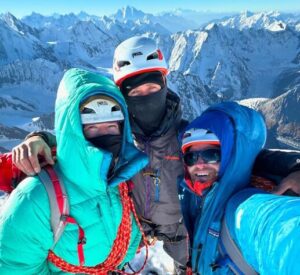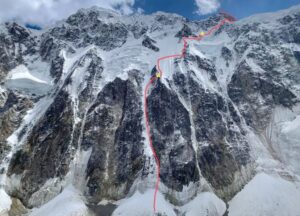In one of the best alpine-style climbs of the last few years, Tom Livingstone and Ales Cesen made the first ascent of the west ridge of 7,946m Gasherbrum III. They named their route Edge of Entropy.
Gasherbrum III lies in the Karakoram on the border between Pakistan and China. Different sources indicate its altitude as 7,952m or 7,958m, but according to 8000ers.com, the correct height is 7,946m.
Gasherbrum III is not considered an independent mountain but a sub-peak of Gasherbrum II. It’s the world’s second-highest sub-peak, after 8,011m Broad Peak Central. Despite this, its difficulty makes it a rarely attempted climbing objective. It’s almost a forgotten peak.

Halina Kruger-Syrokomska at Camp 3 of Gasherbrum II. The east face of Gasherbrum III lies behind. Photo: Leszek Cichy
A short climbing history
Before the summer of 2024, Gasherbrum III was summited only twice.
It was first ascended by a Polish party on August 11, 1975. That day, Wanda Rutkiewicz, Alison Chadwick-Onyszkiewicz, Janusz Onyszkiewicz, and Krzysztof Zdzitowiecki topped out. They climbed via the southeast face, traversing from Camp 3 on Gasherbrum II’s normal route.
A Spanish team carried out the second ascent of Gasherbrum III 29 years later. On July 26, 2004, Alberto Inurrategui and Jon Beloki summited via the Polish route. Jose Carlos Tamayo, the third member of the Spanish team, turned back 200m below the summit.

The Gasherbrum Base Camp of Tom Livingstone and Ales Cesen in 2022. Photo: Tom Livingstone
The 1985 southwest ridge attempt
In the summer of 1985, Geoffrey Cohen from the Scottish Mountaineering Club led an expedition to to the southwest ridge of Gasherbrum III. Though they don’t succeed, this was an important attempt, because Cesen and Livingstone followed the same route in 2024.
The Scottish team’s original objective was the north ridge of Gasherbrum III, which Riccardo Cassin had scouted in 1958. However, Cohen, Paul Nunn, Clive Rowland, and Des Rubens eventually decided on the long, rocky southwest ridge. The ridge rises from the top of the dangerous 800m icefall between Gasherbrum II and Gasherbrum IV.

Scottish mountaineer Des Rubens. He died in the Alps in 2016. Photo: G. Cohen
On their first push, bad weather forced them to return to base camp for a week. But on August 11, they regained Camp 2 in deep snow. Soon after, some team members left the expedition, but Rubens and Cohen remade the trail to the upper cirque and embarked on the ridge on August 14.
They bivouacked at 7,400m on a very exposed patch of snow. On August 15, they left their bivouac gear behind and attempted to reach Gasherbrum III’s summit, hoping to return the same day. After four hours of unroped climbing, they had to start climbing in pitches. This slowed them considerably.
They reached 7,700m, near a horizontal step below the summit tower, but bad weather and strong winds compelled a retreat.
Livingstone and Cesen
So why did Livingstone and Cesen focus on this rarely attempted peak?
“Gasherbrum III was the realization of a 10-year idea: to climb a technical, high-quality alpine route at about 8,000m,” Livingstone wrote. “I had always wondered if you could take the difficulty of the Alps, Alaska, or the Canadian Rockies and supercharge them [with] altitude.”

Livingstone and Cesen during their 2022 Gasherbrum III expedition. Photo: Tom Livingstone/Ales Cesen
Cesen first suggested Gasherbrum III to Livingstone in 2021. A year later, the duo wanted to attempt the peak via the west ridge, but strong winds convinced them to try the northwest face. They bivouacked on the face at 7,600m, where it was windy and snowing.
They climbed to 7,800m, where they were stopped by a rock tower about 100m high. It was too difficult to climb in tricky conditions and couldn’t be easily bypassed. They returned to their camp at 7,100m, and over the next two days, they descended to base camp. According to their report in the American Alpine Journal, the forecast for the next two weeks was dire, so they decided to return home.

Descending from 6,000m to Base Camp through a crevassed glacier at night. From Livingstone and Cesen’s 2022 expedition. Photo: Tom Livingstone
Southwest ridge 2024
This year, Livingstone and Cesen targeted the southwest ridge that the Scottish party had attempted in 1985. Cohen, who led that expedition, was very encouraging. He sent them an expedition report and photos and provided motivation, Livingstone said in an interview with UK Climbing.
Once in Pakistan, Livingstone and Cesen had to walk 112km over six days up the Baltoro Glacier to reach Gasherbrum Base Camp at 5,000m.
“On the way, we had stunning views of the…Trangos, Gasherbrum IV, Masherbrum, K2, and Broad Peak,” Livingstone wrote. “The walk was smooth, contemplative, and each day more exciting. We were back for a rematch.”
It was the first time either climber had returned to a mountain they had already attempted.

Broad Peak, left, and K2, right, from a bivy site at 7,600m on Gasherbrum III. Taken during Livingstone and Cesen’s 2022 attempt. Photo: Tom Livingstone
To acclimatize, Livingstone and Cesen made three trips up the normal route on Gasherbrum II over three weeks. They spent one night at 7,000m before returning to Base Camp. After that night, Cesen became very dizzy.
“We rested for a week and tried to find some useful drugs,” Livingstone wrote.
During the week that Cesen was sick, there was a very good weather window. By the time he had recovered, the weather seemed unsettled but mostly fair. The two climbers decided to take a shot at Gasherbrum III.
The ascent
At the end of July 2024, Livingstone and Cesen launched their summit push.
From Base Camp, they walked through an icefall and over some crevasses to reach Camp 1 at 6,000m. From here, most teams head for the normal routes on Gasherbrum I and II.

Starting the new route. Photo: Tom Livingstone/Ales Cesen
On the second day of the ascent, Livingstone and Cesen ascended from Camp 1 to the col between Gasherbrum IV and Gasherbrum III, at around 7,100m. There, they pitched their tent.
While they were ascending from 7,100m to 7,500m, they found a rope left by the Scottish team in 1985.
“We didn’t expect to find the rope, neatly coiled and under a few rocks,” Livingstone recalled. “From the start of the ridge, the climbing was great. It featured rocky slabs and great mixed climbing. These pitches were surprisingly tricky.”

Tom Livingstone in an uncomfortable bivy at 7,500m. Photo: Ales Cesen
Uncomfortable bivouacs
At 7,500m, Livingstone and Cesen used rocks to make a small ledge for their bivy but soon hit ice underneath. According to Livingstone, there was a flattish platform about 30m below them, but either they were too tired or already a bit affected by the altitude because they didn’t go down to it. Instead, the duo spent an uncomfortable night on the ledge at 7,500m.
The next bivouac at 7,800m was even worse. They sat in an open bivy while getting snowed on.

On Gasherbrum III. Photo: Tom Livingstone/Ales Cesen
At 7,600m, they climbed a hard M6 pitch. Finally, they topped out on August 4.
On reaching the summit, Livingstone recalled that they mostly felt fatigue and satisfaction: “I also remember the sense of isolation and exposure. Imagine going far out and then going a lot further.”
The descent
“I’m always a little anxious about [the descent],” Livingstone wrote later. “Being at that altitude with just a half rope is certainly cutting it a little fine.”
The two climbers descended the line used by the two other successful ascents of Gasherbrum III (the Polish 1975 expedition and the Spanish team in 2004). To finish the descent, they traversed to Gasherbrum II’s normal route and used its fixed ropes, which changed their style but made sense from a safety perspective.

The difficult west ridge of Gasherbrum III. Photo: Tom Livingstone/Ales Cesen
On the seventh day, they reached Base Camp. Livingstone and Cesen then walked 60km over several days to the nearest road.
“We named the route Edge of Entropy because we were always on the edge…of chaos,” Livingstone said. “We would have still climbed even if nobody knew or cared about it. I’ve even been wondering if I should post anything on my Instagram. Anyway, this concludes our adventure. A little step into our own unknown, returning to where we started, richer and happy.”

On the Edge of Entropy. Photo: Tom Livingstone/Ales Cesen

Tom Livingstone and Ales Cesen on the summit of Gasherbrum III. Photo: Tom Livingstone/Ales Cesen






